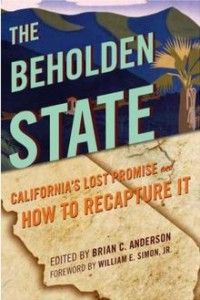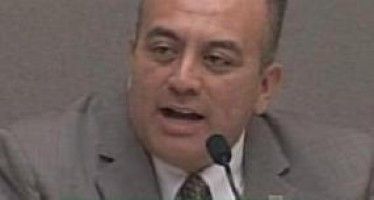Book describes CA problems, how to fix them: Part 1

 This is Part 1 of a two-part series. Part 2 is here.
This is Part 1 of a two-part series. Part 2 is here.
If you listen to Gov. Jerry Brown and his allies, “California is back” from the deficits and dysfunction of a few years ago. Not so fast. A new book examines the problems that still plague the state — and will continue to do so until sensible reforms are enacted.
“The Beholden State: California’s Lost Promise and How to Recapture It” is a collection of essays edited by Brian C. Anderson, the editor of City Journal, which is published by the Manhattan Institute; and which has a special California edition edited by Ben Boychuk. So the book is solidly grounded in experts on the Golden State.
It is the “Beholden State” today because it is beholden to so many mistakes of the past, which are dissected in the book’s essays: overweening union power, a dysfunctional tax code, broken roads and failing schools. Fortunately, the book also provides essays showing how to make things better — without the Pollyannaish gloss put on things by the governor.
The forward is by Bill Simon, who lost a bid for governor in 2002 to then-Gov. Gray Davis, who ended up recalled the next year. Writing of the massive exodus of businesses during the years of Davis and his successor, Arnold Schwarzenegger, Simon laments, “I’ve lost count of the business people I know personally who have either decided to expand their operations out of state or simply pulled up stake and left entirely.”
He points to the “endless accretion of regulations,” in particular AB 32, the Global Warming Solutions Act of 2006, which Schwarzenegger signed. It greatly increases the cost of electricity, boosting business costs. And Simon points out that California’s public schools, “once among the nation’s best, now compete with Mississippi’s for the dubious distinction of the lowest student achievement in reading and math.”
Teachers’ unions
Which brings us to “The Worst Union in America,” a chapter by Troy Senik, a columnist and member of the editorial board of the Orange County Register (where I also write editorials). He’s writing about the California Teachers Association. He points out that the decline began in 1975 when Brown, during his first stint as governor, signed the Rodda Act, allowing collective bargaining for teachers’ unions. As I have described it, this meant teachers elected their own bosses; so they sit on both sides of the bargaining table, as workers and as the employer (by electing pliable legislators and local school boards).
Mandatory dues of up to $1,000 a year per member fatten the CTA’s coffers. During the decade of the 2000s, the union spend $210 million on political campaigns to maintain its power and to keep the tax money flowing to high pay, lucrative pensions and the union’s own coffers.
The kids? Union power ensured “stifling reform efforts at the local level,” Senik writes. It has made it nigh impossible to fire even the worst teachers. The Los Angeles Unified School District, “home to 33,000 teachers — has dismissed only four” in the past decade.
The California State Teachers’ Retirement System has “about $56 billion in liabilities.” CalSTRS itself recently announced it needs $4.5 billion a year for 30 year to remain solvents. That amount was not included in the fiscal 2013-14 state budget Brown signed in June, meaning his boast of it being “balanced” was not accurate.
As Senik notes, the real tragedy here is the loss of generations of students who have been badly educated; and who will not be contributing to the state’s economy at their full potential.
Anti-Business
That’s assuming there even will be jobs for these public-school graduates, even those who went to a decent school. In one of four essays in the volume, Steven Malanga, senior editor at City Journal, takes on, “Cali to Business: Get Out!” He also has written “The New New Left,” a book which I reviewed for the Register.
His chapter in the new book is subtitled, “Firms Are Fleeing the State’s Senseless Regulations and Confiscatory Taxes.”
He notes that California, despite somewhat higher taxes than other states, long was a magnet for business and jobs because of its ideal climate, “a world-class public university system” that churned out able workers, “sturdy infrastructure” and “a history of innovative companies.”
Many companies still innovate, but most are high-tech firms with few employees located in Silicon Valley or San Francisco. The latest example was Twitter’s IPO, which just created 1,600 new millionaires and $2.2 billion in new revenue for the state. Great for them. But Twitter, Facebook, Google and the other firms have not created the millions of middle-class jobs that departed when much of the aerospace industry left in the early 1990s.
Those jobs aren’t coming back, Malanga says, because “California has transformed into a relentlessly antibusiness state,” whose remaining redeeming features — the weather still is great — “haven’t been enough to keep firms from leaving. Relocation experts say that the number of companies exiting the state for greener pastures has exploded.”
He recites how Gov. Gray Davis, upon taking office in 1999, signed 33 bills the California Chamber of Commerce labeled “jobs killers.” And despite a pro-business orientation during Gov. Arnold Schwarzenegger’s first two years in office, 2003-05 — such as the 2005 workers’ compensation reform — the anti-business onslaught has contiued. After losing his Reform Slate in November 2005, Schwarzenegger switched and became anti-business. Brown, with the $7 billion tax increase of Proposition 30 last year and numerous anti-business bills, also has been anti-business.
After an anti-business tax and regulatory environment, Malanga also brings up the state’s position as “America’s most expensive litigation environment for firms.”
CA vs. CA
The always insightful Joel Kotkin, now a professor at Chapman University and columnist with the Orange County Register, writes on, “The Golden State’s War on Itself: How Politicians Turned the California Dream Into a Nightmare.”
He writes that, from 2003 to 2007, the state’s population grew by just 5 percent. But “state and local government grew by 31 percent.” I would add that these were the years of Schwarzenegger, a Republican governor who was elected during the 2003 Gray Davis recall precisely because voters wanted to rein in state spending and endemic deficits. Arnold promised to “blow up the boxes” of state waste and bureaucracy — but ended up expanding the boxes.
Moreover, the state’s percentage of overall U.S. employment has dropped a remarkable 10 percent since 1990. Kotkin contrasts the old progressives, such as Gov. Hiram Johnson and other reformers of the 1910s through the 1950s, who promoted business and growth to advance prosperity, with the modern “progressives,” such as Gov. Jerry Brown (both in the 1970s and now), who push restrictions on growth.
The slack was supposed to be taken up by the “green economy.” But instead of the reasonable regulations of “conservation” efforts in the last century, now, Kotkin writes, the greens are “an impediment to social and economic progress.” In particular, regulations such as AB 32 have severely curtailed industrial jobs, which are higher paying that service jobs.
In this new “progressive” economy, only high-tech CEOs and government workers are prospering. The way back to “the state’s promise,” Kotkin urges, is through “only sustained, broadly based economic growth.”
Part 2 will be published tomorrow.
Related Articles
For 2nd straight election, inattention leads to huge Assembly upset
In 2012, Republican officials were appalled at the incompetence of Lancaster City Councilman Ron Smith, a Republican who somehow managed
Corbett bill would end independent union audits
June 12, 2013 By Katy Grimes A bill written and sponsored by the union labor group State Building and Construction
9th Circuit protects conceal-carry gun rights
What’s it with California politicians and their obsession with grabbing our guns? They are guarded by heavily armed state troopers,




